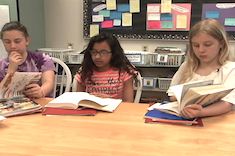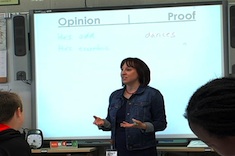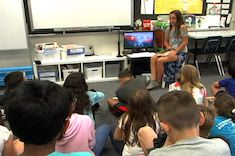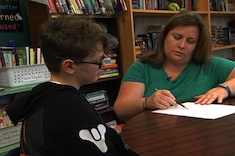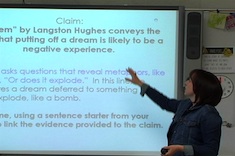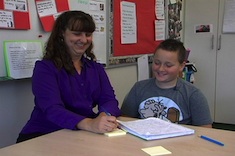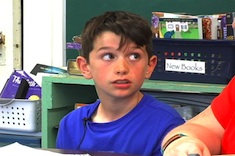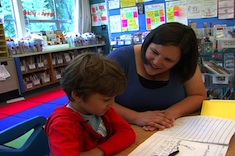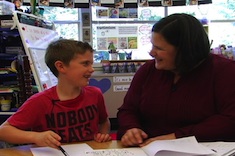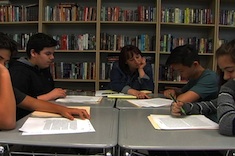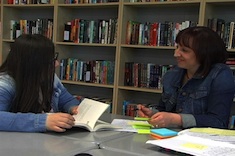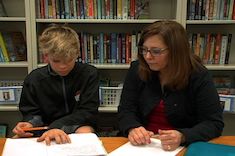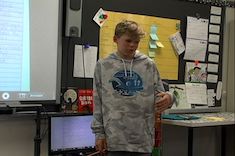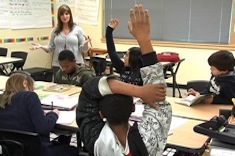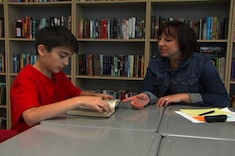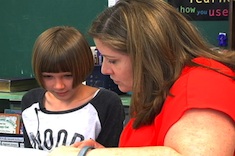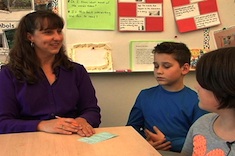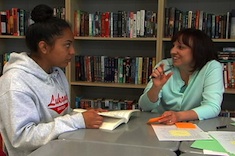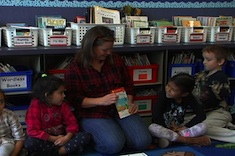Videos
Here is where you’ll find all the latest videos from our contributors. These videos are all captured in classrooms with crews using multiple cameras during regularly scheduled reading and writing workshops.
Latest Content
A Minilesson on Minilessons
Franki Sibberson leads a minilesson in her fifth-grade classroom to help students design their own lessons. Students also assess what goes into a high-quality minilesson.
Stretching Writing in First Grade with Details
Bitsy Parks makes the home-school connection with first grader Grace early in the year as she writes about her birthday party.
Small Group: Creativity
Franki Sibberson pulls together a group of fifth graders to explore writing mentors together.
Opinion Proof Lesson
Christy Rush-Levine helps her students create an “opinion proof chart” in their notebooks. This exercise helps them build their skills in backing up opinions with evidence.
Student-Led Minilesson: Annotating Reading with Sticky Notes
Students can claim who they are as readers and writers by designing and presenting minilessons to their peers. In this week’s video, fifth grader Reagan from Franki Sibberson’s classroom presents a lesson on annotating reading with sticky notes.
Crafting the Basics: First-Grade Writing Conference
Bitsy Parks confers with Aubrey early in the year, using books from whole-class lessons as a scaffold for understanding key text elements like title, author, and illustrations.
Exploring Dystopian Literature: Fifth-Grade Reading Conference
Katherine Sokolowski confers with Ian about The Giver, broadening his understanding of the text to consider other dystopian literature.
Revising Literary Analysis Essays: Supporting Claims
Christy Rush-Levine presents a minilesson to her eighth-grade students about revising their literary analysis essays, using an analogy about putting furniture together.
Thoughtful Read Aloud Structures
Franki Sibberson shares how she integrates student choice and collaboration into reading response during daily read alouds.
Analyzing Voice: Conferring with Griffin
Gigi McAllister helps fourth grader Griffin re-engage with his writing by pointing out some of the unique qualities of voice and style his piece possesses.
Clapping Syllables Routine in First Grade
Bitsy Parks works with her first graders early in the year to teach them the basics of how words are constructed, by clapping through syllable counts.
Practical Advice for Dealing with Messy Handwriting
Do struggles with handwriting matter? They do when a student can’t even decipher his own words. Katherine Sokolowski confers with fifth grader Sauvi to help him find solutions to the problem.
First-Grade Writing Conference: Celebrations to Suggestions
Katrina Edwards begins her conference with first grader Allen by celebrating all he is doing well in his writing. She highlights his language and details in writing before moving on to new strategies to try.
Reading The Crossover: Fourth-Grade Reading Group
Gigi McAllister leads a group of boys who are just starting the novel in verse The Crossover in her fourth-grade classroom.
First-Grade Conference: Finding Seeds in Writing
Katrina Edwards confers with a first-grade writer and helps him unpack a narrative to use as seed writing.
Evidence Claims in a Middle School Small Group
Christy Ruth-Levine leads a small group of eighth graders as they explore how to include textual evidence in their literary analysis essays.
Reading Minilesson: A Good Partner
Katrina Edwards helps her first graders early in the year transition to more thoughtful reading partnerships through a minilesson at the start of the morning workshop.
First-Grade Word Learning with Kinesthetics
Katrina Edwards teaches her first graders the word much using kinesthetics.
Moving Beyond Pokemon: Conferring with Clover
Bitsy Parks works with a first grader stuck on writing about Pokemon characters. She uses other writing from Clover to nudge her to try something new.
Cause and Effect: Conferring with Olivia
Christy Rush-Levine confers with Olivia about the principle of cause and effect in the novel she is reading.
Linking Pictures and Text: Conferring with Ava
Katrina Edwards begins her conference with first grader Ava by having her share what she learned from a picture walk through a simple text, and then she helps her use pictures to decode text while reading.
Planning a Student-Led Minilesson
Franki Sibberson helps Lucas plan his minilesson for his fifth-grade classmates on how to connect words and facts from two different sources.
Student-Led Minilesson: Connecting Facts from Different Sources
Lucas leads a minilesson in Franki Sibberson’s fifth-grade class on connecting facts from different sources.
Balancing Whole-Class and Independent Reading in Middle School
The choice between whole-class novels or independent reading can be a false one in many middle school classrooms. Katie Doherty’s sixth graders discuss their reading together of a novel in verse, and Katie explains how some shared whole-class texts can support independent reading.
History Through a Child’s Eyes: Conferring with Omar
Christy Rush-Levine confers with Omar, who is reading The Rock and the River. The book is a fictional account of a tumultuous time in civil rights history, considering protests through a child’s eyes.
A Poem About Lost Friendship: Conferring with Estelle
Estelle shares a poem she has written about lost friendship with her teacher, Katherine Sokolowski. She captures the fickle nature of fifth-grade relationships among girls. Katherine connects the cadence of the writing to the style of The Crossover, and helps Estelle find possibilities for more writing.
Reading Partners: Process Discussion
Gigi McAllister helps fourth-grade reading partners evaluate their success and areas to work on in their partnership.
Reading Conference: Keeping Track of Characters
Christy Ruth-Levine confers with Edith, who is tracking character changes in the novel Room.
Making Meaning with Simple Text: Conferring in First Grade
Katrina Edwards confers with a first grader, looking beyond the level of the book early in the year to ensure the child is engaging with the story. She helps the child notice changes in the simple text and illustrations.
First-Grade Reading Share: Focus on Conferring and Strategies
Bitsy Parks uses reading share time early in the year to describe and summarize the work in two conferences to help students learn how conferring, independent reading time, and strategy practice work. One of the books used in a conference is from a recent read aloud.
Browse Content By
Type
Category
- Assessment Tools
- Big Fresh Archives
- Booklists
- Choice Numeracy
- Classroom Design
- Common Core
- Community Building
- Conferring
- Content Literacy
- Digital Literacy
- English Language Learners
- Equity
- Family Relations
- Free Samples
- Guiding Groups
- Leadership
- Literacy Coaches
- Mentor Texts
- Minilessons
- New Teacher Mentors
- Podcasts
- Poetry
- Quote Collections
- Reading Strategies
- Self Care
- Struggling and Striving Learners
- Talking and Listening
- Teacher Study Groups
- Teaching Reading
- Teaching Writing
- Word Study and Vocabulary
Author
- Melissa Quimby
- Nawal Qarooni
- Gwen Blumberg
- Julie Cox
- The Lead Learners
- Hannah Tills
- Josie Stewart
- Ruth Metcalfe
- Mallory Messenger
- Becca Burk
- Jodie Bailey
- Vivian Chen
- Mary Brower
- Tiffany Abbott Fuller
- Stephanie Affinito
- Ruth Ayres
- Leigh Anne Eck
- Heather Fisher
- Shari Frost
- Julie Johnson
- Suzy Kaback
- Gigi McAllister
- Shirl McPhillips
- Melanie Meehan
- Cathy Mere
- Debbie Miller
- Tara Barnett and Kate Mills
- Tammy Mulligan
- Dana Murphy
- Bitsy Parks
- David Pittman
- Brenda Power
- Heather Rader
- Matt Renwick
- Mandy Robek
- Christy Rush-Levine
- Gretchen Schroeder
- Jen Schwanke
- Brian Sepe
- Katherine Sokolowski
- Stella Villalba
- Jennifer Vincent
Grade Level
Choice Literacy Membership
Articles
Get full access to all Choice Literacy article content
Videos
Get full access to all Choice Literacy video content
Courses
Access Choice Literacy course curriculum and training



